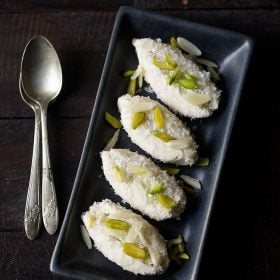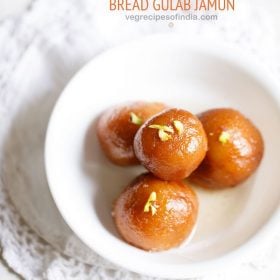Well, if you want to prepare the Gulab Jamun in a faster way, here’s your foolproof recipe that I have shared on this post. This Gulab Jamun With Milk Powder is a cheat’s version but tastes equally good. The recipe comes handy if you don’t have khoya or paneer/chenna readily available. All you need is milk powder, curd (yogurt), sugar and water to make a tasty batch of this famous Indian mithai (sweet) at home.

About Gulab Jamun With Milk Powder
In the enchanting world of Indian sweets, where traditions meet innovation, the Gulab Jamun With Milk Powder stands as a beloved variation of the classic mithai, offering a quicker and equally delectable route to this iconic dish.
The base of this Gulab Jamun With Milk Powder is obviously made from milk powder, which, when mixed with a bit of all-purpose flour, a touch of ghee, and some curd, forms a soft, pliable dough.
This dough is kneaded gently until smooth and then shaped into small, round balls, ensuring there are no cracks for a perfect texture. It is paramount to get the apt texture of the dough to make these.
Once you have achieved that, it’s as easy as a breeze to make them, and you won’t even head to the market to buy them.
As these balls or jamuns are gently fried in oil, they turn a beautiful golden brown, their surfaces crisping up while the insides remain soft and spongy.
The key to perfect gulab jamuns lies in frying them slowly over medium heat, allowing them to cook evenly and develop their signature color and flavor.
Once fried, the Gulab Jamun With Milk Powder is immediately immersed in a warm, fragrant sugar syrup, infused with the delicate flavors of cardamom, saffron and chopped pistachios.
The syrup seeps into the fried balls, infusing them with sweetness and making them irresistibly moist and juicy.
The transformation is magical: what starts as simple ingredients turns into a luscious sweet that melts in your mouth with every bite.
The milk powder gives the gulab jamuns a soft and light texture with a rich flavor and syrup-soaked goodness that remain unparalleled.
Served warm or at room temperature, Milk Powder With Gulab Jamun is a festive treat that brings joy to any occasion.
Whether enjoyed during celebrations, festivals, or as a sweet ending to a meal, these gulab jamuns capture the essence of Indian mithai, offering a taste of tradition with a modern twist.
How to make Gulab Jamun With Milk Powder
Make Sugar Syrup
1. First, stir and mix 1.5 cups sugar, 1 cup water, ½ teaspoon green cardamom powder and 12 to 15 saffron strands in a pan and place it on heat.
I have kept the cardamom peels and these can be discarded when serving.
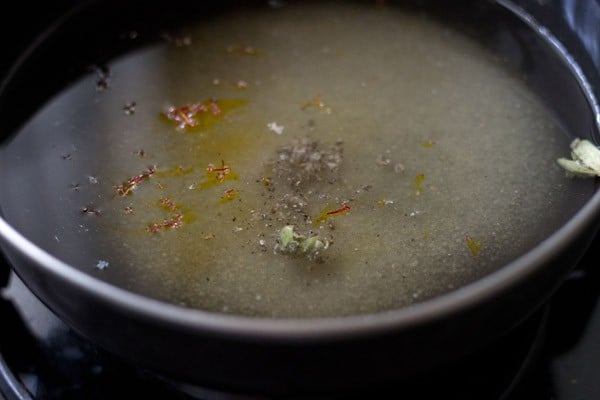
2. Gently bring to a boil and continue to stir occasionally.
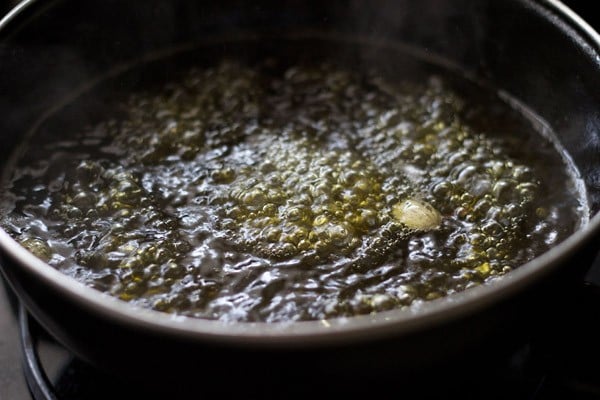
3. Add 1 tablespoon chopped pistachios. Make a thick syrup and turn off the heat much before the sugar solution reaches a one-thread consistency.
Adding pistachios is optional but the syrup tastes good with these nuts
You can cook the sugar syrup till it reaches a half-string consistency. On cooling, if the sugar syrup crystallizes, then add 2 to 3 tablespoons water and warm the syrup again. It will again return to a liquid state.

Make Milk Powder Dough
4. Mix 1 cup milk powder, ¼ cup all-purpose flour, a pinch of baking soda and a pinch of salt (optional) in a mixing bowl.
Add 1 teaspoon oil or ½ teaspoon ghee and 1 to 2 tablespoons fresh curd (yogurt).

5. Mix everything lightly. Add some more curd, if the mixture looks dry. Don’t over mix or knead. You don’t want gluten to form. Just mixing well is enough.
The all-purpose flour is added to bind the mixture. If gluten forms, then the dough balls become dense and won’t absorb any of the sugar syrup and the jamun will not be soft.
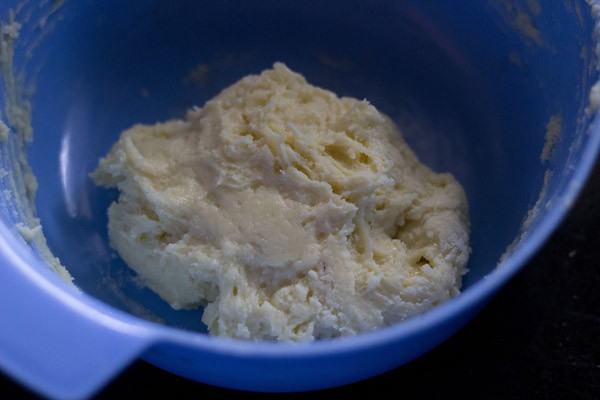
6. The mixture will be sticky but smooth. Apply some oil on your palms and make small balls from the dough.
These dough balls almost double when frying and also increase when soaked in the sugar syrup. So, don’t make large-sized balls.
There should be no cracks on the dough balls. They should be smooth. If there are cracks, then add some 1 or 2 teaspoons curd or milk to the mixture and continue making the balls. Once done, cover the balls with a kitchen towel.

Fry dough balls
7. Heat oil for deep frying in a kadai or a pan. When the oil is medium hot, lower the heat. Add a small ball in the oil. The ball should slowly rise to the top from the bottom.
If it does not rise, the oil is not hot enough. Whereas, rising quickly and also turning brown quickly, means the oil is too hot to fry.
If it does not crack or break while frying, you are alright to proceed further. If it cracks, add some 1 or 2 teaspoons flour to the dough and form the balls again.
In an ideal case, the dough ball should not crack and must rise slowly to the top and must not get browned quickly.

8. When you know the oil is hot enough, on low or medium-low heat, add 3 to 4 balls or more depending on the capacity of your kadai or pan.
Once the the sides touching the oil become light golden or golden, turn over the balls with a slotted spoon. Keep in mind the balls have to be stirred with a slotted spoon frequently to get even browning.
But take care as hot oil is there in the pan. The balls should also not become browned too soon. They have to be cooked from the inside too.

9. Keep turning until they turn golden. If the oil becomes cold, don’t fry the balls. Increase the temperature and then fry.
Otherwise, they would have a hard crispy thick crust when fried in a less hot oil and they won’t absorb the sugar syrup. Plus, they will absorb a lot of oil too.
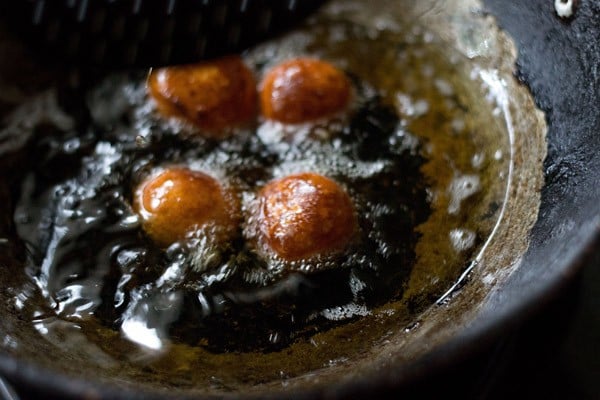
Soak In Sugar Syrup
10. When the balls are evenly golden and browned, remove with slotted spoon and add them directly in the prepared sugar syrup. Keep them in the sugar syrup for at least 1 to 2 hours before serving.
This is done so that they soak up the sugar syrup which will make them soft and sweet. That’s why in the mithai shops, the gulab jamun are always soaked in sugar syrup.
If you feel the jamun is not soaking in the sugar syrup, then warm the entire sugar syrup with the jamuns for a couple of minutes on stovetop. Cover and keep aside. Just warm them, don’t heat.
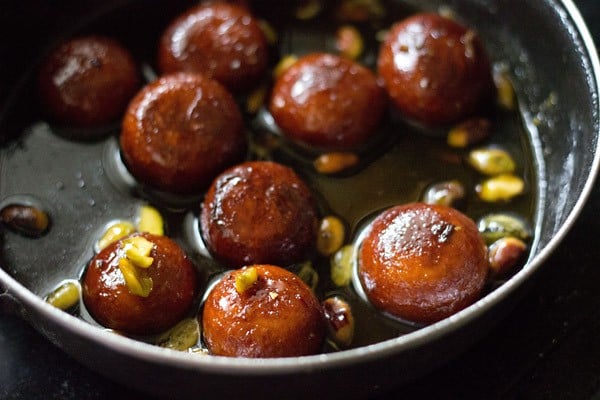
11. Gulab Jamun With Milk Powder can be served warm or cold.
If they are at room temperature, warm in the microwave and serve them topped with sugar syrup and garnished with pistachios or almond slices.

More Indian Sweets Recipes To Try!
North Indian Food Recipes
Sweets Recipes
Sweets Recipes
Sweets Recipes
Please be sure to rate the recipe in the recipe card or leave a comment below if you have made it. For more vegetarian inspirations, Sign Up for my emails or follow me on Instagram, Youtube, Facebook, Pinterest or Twitter.

Gulab Jamun With Milk Powder
Ingredients
For the Jamun
- 1 cup milk powder
- ¼ cup all-purpose flour
- 1 teaspoon oil OR ½ teaspoon ghee
- 1 pinch salt (optional)
- 1 pinch baking soda
- 1 to 2 tablespoons Curd (yogurt)
- 1 tablespoon pistachios – blanched or almond slices; for garnish
For the sugar syrup
- 1 cup water
- 1.5 cups sugar
- 3 to 4 green cardamoms – husked and crushed or powdered or ½ teaspoon cardamom powder
- 12 to 15 saffron strands – optional
- 1 tablespoon rose water – optional
Instructions
Making Sugar Syrup
- First mix the sugar, water, cardamom powder and saffron in a pan and keep it on the stovetop.
- Gently bring to a boil and continue to stir occasionally.
- Add some pistachios in the syrup. An optional step but tastes good. Make a thick sticky syrup and turn off the stovetop; much before the sugar solution reaches a one thread consistency.
- You can cook the sugar syrup till it reaches a half string consistency. On cooling, if the sugar syrup crystallizes, then add 2 to 3 tablespoons water and warm the syrup again. It will again return to a liquid state.
Making Milk Powder Dough Balls
- Mix the milk powder, all-purpose flour or maida, a pinch of baking soda, a pinch of salt (optional) in a mixing bowl. Add 1 teaspoon oil OR ½ teaspoon ghee and 1 to 2 tablespoons fresh curd or yogurt.
- Just mix everything lightly. Add some more curd if the mixture looks dry. Don’t over mix or knead.
- You don’t want gluten to form, so just mixing well is enough. The all-purpose flour is just added to bind the mixture. If gluten forms then the dough balls become dense and won’t absorb any of the sugar syrup and the jamun will not be soft.
- The mixture will be sticky but smooth. Apply some oil on your palms and make small balls from the dough. These dough balls almost double when frying and also increase when soaked in the sugar syrup. So don’t make large sized balls.
- There should be no cracks on the dough balls. They should be smooth. If there are cracks, then just add some 1 or 2 teaspoons of curd or milk to the mixture and continue making the balls.
- Once done, then cover the balls with a kitchen towel.
Frying
- Heat oil for deep frying in a kadai or a pan. When the oil becomes medium hot, lower the heat.
- Add a small ball in the oil. The ball should slowly rise to the top from the bottom. If it does not rise then, the oil is not hot enough. If it rises quickly and browns also quickly, then the oil is too hot to fry.
- If the small ball does not crack or break while frying, you are alright to proceed further. If it cracks, then just add some 1 or 2 teaspoons flour to the dough and form the balls again. In an ideal case, the dough ball should not crack and should rise slowly to the top and should not get browned quickly.
- When you know the oil is hot enough and on a low heat or medium-low heat, then add 3 to 4 balls or more depending on the capacity of your kadai or pan.
- When the sides touching the oil, become light golden or golden, turn over the dough balls with a slotted spoon and fry the remaining sides.
- The balls have to be stirred with a slotted spoon frequently to get even browning. But take care as hot oil is there in the pan. The balls should also not become browned too soon. They have to be cooked from the inside too.
- Keep on turning the balls until they become golden. If the oil becomes cold, then don’t fry the balls. Increase the temperature and then fry. Otherwise, the balls would have a hard crisp thick cover when fried in a less hot oil and they won’t absorb the sugar syrup. Plus they would absorb a lot of oil too.
Soaking jamun in sugar syrup
- When the balls are evenly golden and browned, remove from the slotted spoon and add them directly into the sugar syrup.
- Keep the fried golden balls in the sugar syrup for at least 1 to 2 hours before serving. This is done so that the jamun soaks up the sugar syrup which will make them soft and sweet. That’s why in the sweet shops, the gulab jamun are always soaked in sugar syrup.
- If you feel the jamun is not soaking in the sugar syrup, then warm the gulab jamuns together with the sugar syrup on stove-top for a couple of minutes. Cover and set aside. Just warm the sugar syrup, don’t heat.
- Gulab jamun can be served warm or cold. If they are at room temperature, then warm in the microwave and serve them topped with sugar syrup and garnished with pistachios or almond slices.
Notes
- Ensure to mix the dough ingredients and do not knead like a roti dough. The dough should be mixed enough so as to make neat round balls from it.
- Kneading or overdoing the mixing, may result in the development of gluten in the dough, which will make for dense or hard texture in the jamuns.
- Do not fry on a high heat as this will brown the jamuns quickly from outside leaving the inside dough undercooked.
- Also, do not fry in oil which is not hot enough, as this will make the dough balls absorb too much of oil.
Nutrition Info (Approximate Values)
This Gulab Jamun With Milk Powder from the archives was first published on September 2013. It has been updated and republished on June 2024.

